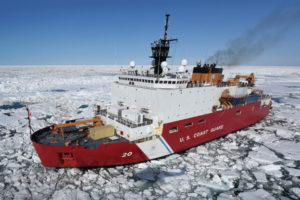 The 420-foot U.S. Coast Guard cutter Healy has departed from her homeport of Seattle for a four-month deployment to the Arctic Ocean to carry out scientific research. The Healy is the United States’ newest and most technologically advanced polar icebreaker and is designed to break through four and a half feet of ice continuously at three knots at temperatures as low as -50 degrees Fahrenheit. She has a permanent crew of 87 sailors and is capable of operations ranging from search and rescue, ship escort, environmental protection, and the enforcement of laws and treaties of the Polar Regions.
The 420-foot U.S. Coast Guard cutter Healy has departed from her homeport of Seattle for a four-month deployment to the Arctic Ocean to carry out scientific research. The Healy is the United States’ newest and most technologically advanced polar icebreaker and is designed to break through four and a half feet of ice continuously at three knots at temperatures as low as -50 degrees Fahrenheit. She has a permanent crew of 87 sailors and is capable of operations ranging from search and rescue, ship escort, environmental protection, and the enforcement of laws and treaties of the Polar Regions.
The Healy will primarily conduct three missions focused on the biology, chemistry, geology, and physics of the Arctic Ocean and its ecosystems, and will also perform multibeam sonar mapping of the Extended Continental Shelf (ECS). The first mission will include the coordination of 46 researchers from the National Oceanic and Atmospheric Administration (NOAA) and University of Alaska-Anchorage to deploy the remotely operated vehicle Global Explorer, net trawls, bottom cores, and conductivity, temperature, and depth sensors to assess the biological diversity of the Chukchi Sea. Healy’s crew will also assist with the deployment of an array of acoustic bottom moorings to support research taking place at the Scripps Institute of Oceanography and the Office of Naval Research. The moorings will collect data on how climate change and decreased ice coverage is affecting the Arctic Ocean.
The final and perhaps most pressing mission, funded by NOAA in support of the State Department and the
White House Office of Science and Technology, will facilitate multibeam sonar mapping and bottom dredging for University of New Hampshire researchers. This project is to support the demarcation of the Extended Continental Shelf (ECS). This is the 10th ECS cruise for the Healy and the 8th carried out with the cooperation of the
Canadian Hydrographic Service.
The work directly supports the United States’ claim for the natural resources found on or beneath the ocean floor, which is vital as the Arctic ice recedes and other Arctic nations such as Russia seek claim to newly available territory. While the Healy is the newest and largest icebreaker at the US’ disposal, it was commissioned in 2000 and is still classified as a medium-sized icebreaker by the United States Coast Guard. As the Arctic becomes a new frontier for international contention, will the U.S.’ aging icebreaker fleet be able to contend? We shall see. Russia’s fleet boasts the world’s only nuclear-powered icebreakers that are far more powerful than, and do not have the same fuel limitations of, their deisel counterparts. The 50 Let Pobedy, Russia’s newest nuclear icebreaker, was built in 2007.
Northwest Yachting salutes the crew and researchers aboard the Healy and eagerly await their findings. For more information about the Healy and her missions, visit icefloe.net.